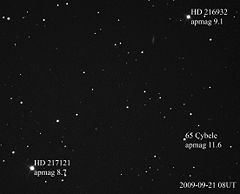- 65 Cybele
-
65 Cybele  Star field showing Cybele towards the lower right.Discovery
Star field showing Cybele towards the lower right.DiscoveryDiscovered by Ernst Wilhelm Tempel Discovery date March 8, 1861 DesignationsNamed after Cybele Alternate name(s) Minor planet
categoryouter main belt[1] (Cybele) Epoch December 31, 2006 (JD 2454100.5) Aphelion 567.544 Gm (3.794 AU) Perihelion 459.654 Gm (3.073 AU) Semi-major axis 513.599 Gm (3.433 AU) Eccentricity 0.105 Orbital period 2323.521 d (6.36 a) Average orbital speed 16.03 km/s Mean anomaly 279.683° Inclination 3.548° Longitude of ascending node 155.808° Argument of perihelion 105.757° Physical characteristicsDimensions 302×290×232 km[2]
273.0±11.9 km[2]
237.3 km IRAS[1]Mass 1.78×1019 kg[3] Mean density 2.55±0.22 g/cm³[3] Equatorial surface gravity 0.0663 m/s² Escape velocity 0.1255 km/s Rotation period 4.041 h[1] Albedo 0.050 ± 0.005[2]
0.071[1]Temperature ~150 K Spectral type C Apparent magnitude 10.67 to 13.64 Absolute magnitude (H) 6.62[1] 65 Cybele (
 /ˈsɪbɨliː/ sib-əl-ee; Greek: Κυβέλη) is one of the largest asteroids in the Solar System and is located in the outer asteroid belt.[4] It gives its name to the Cybele family of asteroids[4] that orbit outward from the Sun from the 2:1 orbital resonance with Jupiter. Cybele is a C-type asteroid, meaning that it is dark in color and carbonaceous in composition. It was discovered in 1861 by Ernst Tempel and named after Cybele the earth goddess.
/ˈsɪbɨliː/ sib-əl-ee; Greek: Κυβέλη) is one of the largest asteroids in the Solar System and is located in the outer asteroid belt.[4] It gives its name to the Cybele family of asteroids[4] that orbit outward from the Sun from the 2:1 orbital resonance with Jupiter. Cybele is a C-type asteroid, meaning that it is dark in color and carbonaceous in composition. It was discovered in 1861 by Ernst Tempel and named after Cybele the earth goddess.Contents
Discovery and naming
Cybele was discovered on March 8, 1861, by Ernst Tempel from the Marseilles Observatory. A minor controversy arose from its naming process. Tempel had awarded the honour of naming the asteroid to Carl August von Steinheil in recognition of his achievements in telescope production. Von Steinheil elected to name it "Maximiliana" after the reigning monarch Maximilian II of Bavaria. At the time, asteroids were conventionally given classical names, and a number of astronomers protested this contemporary appellation. The name Cybele was chosen instead, referring to the Phrygian goddess of the earth.[5]
Physical characteristics
The first Cybelian stellar occultation was observed on October 17, 1979 in the Soviet Union. The asteroid appeared to have an irregular shape, with the longest chord being measured as 245 km, closely matching the diameter of 237 km determined by the IRAS satellite in 1983. During the same 1979 occultation, a hint of a possible 11 km wide satellite was detected.[6]
In 1985, Green estimated Cybele to have a diameter of 330 km.[2] In 2004, Müller estimated Cybele using thermophysical modelling (TPM) to have dimensions of 302×290×232 km.[2] The diameter from IRAS observations in 1983 are listed on the JPL Small-Body Database as 237.26 km (118.63 km radius) as of 2010.[1]
Spectrum
Examination of the asteroid's infrared spectrum shows an absorption feature that is similar to the spectrum of 24 Themis. This can be explained by the presence of water ice. The asteroid may be covered in a layer of fine silicate dust mixed with small amounts of water-ice and organic solids.[7]
Recent occultations
On August 24, 2008, Cybele occulted 2UCAC 24389317, a 12.7 magnitude star in the constellation Ophiuchus.[8] On October 11, 2009, Cybele occulted a 13.4 magnitude star in the constellation Aquarius.[9]
References
- ^ a b c d e f g "JPL Small-Body Database Browser: 65 Cybele". 2010-11-23 last obs. http://ssd.jpl.nasa.gov/sbdb.cgi?sstr=65. Retrieved 2008-11-25.
- ^ a b c d e Müller, T. G; Blommaert, J. A. D. L. (2004). "65 Cybele in the thermal infrared: Multiple observations and thermophysical analysis". Astronomy and Astrophysics 418: 347–356. arXiv:astro-ph/0401458. Bibcode 2004A&A...418..347M. doi:10.1051/0004-6361:20040025.
- ^ a b Jim Baer (2008). "Recent Asteroid Mass Determinations". Personal Website. http://home.earthlink.net/~jimbaer1/astmass.txt. Retrieved 2008-11-28.
- ^ a b Linda T. Elkins-Tanton - Asteroids, Meteorites, and Comets (2010) - Page 96 (Google Books)
- ^ Lutz D. Schmadel, Dictionary of Minor Planet Names, p.21.
- ^ "IAUC 3439: 1979l; Occn OF AGK3 +19 599 BY (65)". MPC (Circular No. 3439). 1980-01-04. http://www.cfa.harvard.edu/iauc/03400/03439.html. Retrieved 2004-06-18.
- ^ Landsman, Zoe; Licandro, J.; Campins, H.; Kelley, M.; Hargrove, K.; Pinilla-Alonso, N.; Cruikshank, D.; Rivkin, A. S.; Emery, J. (October 2010). "Asteroid 65 Cybele: Detection Of Small Silicate Grains, Water-Ice And Organics". Bulletin of the American Astronomical Society 42: 1035. Bibcode 2010DPS....42.3918L.
- ^ IOTA. "(65) Cybele 2008 Aug 24 profile". http://www.asteroidoccultation.com/observations/Results/Data2008/20080824_CybeleProfile.png. Retrieved 2010-12-02.
- ^ Steve Preston. "(65) Cybele / 2UCAC 28838190 event on 2009 Oct 11, 01:30 UT". http://www.asteroidoccultation.com/2009_10/1011_65_22846_Summary.txt. Retrieved 2009-09-21.
External links
- Orbital simulation from JPL (Java) / Ephemeris
Minor planets navigator Small Solar System bodies Minor planets - Designation
- Groups
- Moons
- Meanings of names
- Pronunciation of names
Comets Meteoroids Lists / categories - Asteroid groups and families
- Asteroid moons
- Binary asteroids
- Minor planets
Categories:- Main Belt asteroids
- Cybele asteroids
- C-type asteroids
- Binary asteroids
- Asteroids named from Greek mythology
- Astronomical objects discovered in 1861
Wikimedia Foundation. 2010.
